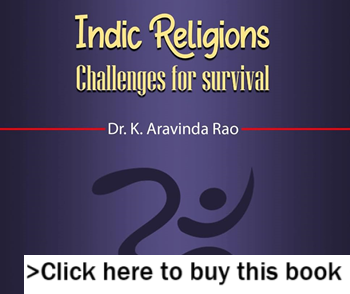Hinduism is rich in scripture and includes an extensive collection of ancient religious writings. These sacred texts are classified broadly into two categories: Shruti and Smriti. The word Shruti literally means “heard” and consists of what Hindus believe to be eternal truths akin to natural law. These texts are revered as “revealed” or divine in origin and are believed to contain the foundational truths of Hinduism.
The second category of scripture is Smriti, which literally means “memory,” and is distinguished from Shruti in terms of its origin. Teachings in Smriti texts are meant to be remind adherents the eternal truths of Shruti, and read and interpreted in light of changing circumstances over kala (time), desha (land), and guna (personality).
Shruti
🚩 Upavedas: The Upavedas consist of four main texts, including:
🚩 Mahabharata: With over 100,000 verses, the Mahabharata is a historical epic, and is the longest poem the world has known. Based on an extended conflict between two branches of the Kaurava family, the Mahabharata is a trove of stories and discourses on the practice of Dharma, including the importance of truth, justice, self sacrifice, and the upholding of Dharma, the need for complete devotion to God, and the ultimate futility of war
🚩 Bhagavad Gita: The Bhagavad Gita is a primary scripture for Hindus. Although it is a tiny part of the Mahabharata and technically classed as a Smriti text, it is traditionally accorded the rank of an Upanishad. It is meant to help one understand that upholding dharma can be challenging, especially in situations where there is not a clear right or wrong.
🚩 Agama Shastras: Ancient and numerous, including many that have been lost over the centuries, these texts deal with practical aspects of devotion and worship, including personal and temple rituals and practices.
Hinduism as an Inspiration for Innovation and Discovery:
Hindu Contributions from Antiquity
Contrary to popular perceptions that Hinduism is a mystical religion exclusively concerned with transcendental concepts of spiritual practice, Hinduism has been a wellspring for vast contributions to global civilization spanning more than five millennia. As a religious practice aspiring to understand the eternal mysteries of existence, Hinduism has never been a regressive or closed dogma satisfied with historicentric interpretations of one holy book. Indeed, Hindus have explored the mysteries of science, mathematics and astronomy to revel in the glory of Creation. Epochal advances in metallurgy, medicine, grammar, music and dance, among other disciplines, came from early practitioners of Hinduism and its scripture is replete with practical and esoteric observations.
🚩 Education: The first university in Takshashila in 700 B.C.E.
🚩 Mathematics: The concept of zero (200 A.D.). The modern numerical and decimal system (300 B.C.E). The value of pi (?) (497 A.D.). Area of a triangle (476 A.D.). Quadratic Equation (991 A.D.). Trigonometry.
🚩 Astronomy: Concept of planets in the solar system circling the sun (500 A.D.). Earth as round, rotating on axis and gravity as a force of attraction by the earth (500 A.D.). Concept of Time as 365 days in a year.
🚩 Metallurgy: Steel, iron, gold discovered in archaeological excavations dating to 3000 B.C.E.
🚩 Medicine: Ayur Veda, a system of allopathic and holistic medicine and now a subject of rediscovery, originated 1000 B.C.E. Detailed text called the Charaka Samhita includes anatomy, physiology and various treatments using various plants, fruits and herbs.
🚩 Surgery: The Sushruta Samhita (600 B.C.E.) is considered the first detailed text with seminal descriptions of surgical procedures and instruments that, with modifications, are conceptually used today.
🚩 Literature: Sanskrit developed as the most ancient systematic language in the world. The Ramayan (before 3000 B.C.E) and the 100,000 verses Mahabharata (300 B.C.E.) are venerable epics that continue to inspire Hindus today.
🚩 Arts: Highly sophisticated Indian classical music finds its origins in the Sama Veda, one of the four original Vedas. The four classical dance forms of India find their origins and inspirations in Hindu religious tradition.
🚩 Yoga and Meditation: These are, perhaps, the most widely-recognized spiritual contributions of Hinduism to humanity. Hatha Yoga, the widely practiced system of cleansing exercises, is only one of the Yoga disciplines that encourage spiritual, physical and intellectual advancement. Meditation, a process that calms and focuses the psyche, is integral to yogic practice and recognized with yoga for its salutary effects on personal well-being.
By: +Prof: Koti Madhav Balu Chowdary
The second category of scripture is Smriti, which literally means “memory,” and is distinguished from Shruti in terms of its origin. Teachings in Smriti texts are meant to be remind adherents the eternal truths of Shruti, and read and interpreted in light of changing circumstances over kala (time), desha (land), and guna (personality).
Some of the most well known texts include:
- Vedas: The word Veda means “knowledge”. There are four Vedas: Rig, Sama, Yajur and Atharva, of which the Rig Veda is the oldest.
- Upanishads: These texts, numbering over 100, contain an extensive exploration of the methods of understanding the self, God, and the nature of the world.
🚩 Upavedas: The Upavedas consist of four main texts, including:
- Ayurveda - science of health and life
- Dhanurveda - science of warfare
- Gandharvaveda - the study of aesthetics, and delineates art forms
- Arthashastra - guidance on public administration, governance, economy, and politics
🚩 Ramayana: This popular epic tells the life story the noble prince named Rama, whom Hindus believe to be an incarnation of the Divine. Prince Rama suffers year of exile and many hardships while destroying powerful demons before returning to rule his kingdom. There are numerous versions of the Ramayana, of which the most well-known are those by the original author Sage Valmiki and the poet-saint Tulsidas.
🚩 Mahabharata: With over 100,000 verses, the Mahabharata is a historical epic, and is the longest poem the world has known. Based on an extended conflict between two branches of the Kaurava family, the Mahabharata is a trove of stories and discourses on the practice of Dharma, including the importance of truth, justice, self sacrifice, and the upholding of Dharma, the need for complete devotion to God, and the ultimate futility of war
🚩 Bhagavad Gita: The Bhagavad Gita is a primary scripture for Hindus. Although it is a tiny part of the Mahabharata and technically classed as a Smriti text, it is traditionally accorded the rank of an Upanishad. It is meant to help one understand that upholding dharma can be challenging, especially in situations where there is not a clear right or wrong.
🚩 Agama Shastras: Ancient and numerous, including many that have been lost over the centuries, these texts deal with practical aspects of devotion and worship, including personal and temple rituals and practices.
Hinduism as an Inspiration for Innovation and Discovery:
Hindu Contributions from Antiquity
Contrary to popular perceptions that Hinduism is a mystical religion exclusively concerned with transcendental concepts of spiritual practice, Hinduism has been a wellspring for vast contributions to global civilization spanning more than five millennia. As a religious practice aspiring to understand the eternal mysteries of existence, Hinduism has never been a regressive or closed dogma satisfied with historicentric interpretations of one holy book. Indeed, Hindus have explored the mysteries of science, mathematics and astronomy to revel in the glory of Creation. Epochal advances in metallurgy, medicine, grammar, music and dance, among other disciplines, came from early practitioners of Hinduism and its scripture is replete with practical and esoteric observations.
___________________
Some perennial contributions of Hinduism:🚩 Education: The first university in Takshashila in 700 B.C.E.
🚩 Mathematics: The concept of zero (200 A.D.). The modern numerical and decimal system (300 B.C.E). The value of pi (?) (497 A.D.). Area of a triangle (476 A.D.). Quadratic Equation (991 A.D.). Trigonometry.
🚩 Astronomy: Concept of planets in the solar system circling the sun (500 A.D.). Earth as round, rotating on axis and gravity as a force of attraction by the earth (500 A.D.). Concept of Time as 365 days in a year.
🚩 Metallurgy: Steel, iron, gold discovered in archaeological excavations dating to 3000 B.C.E.
🚩 Medicine: Ayur Veda, a system of allopathic and holistic medicine and now a subject of rediscovery, originated 1000 B.C.E. Detailed text called the Charaka Samhita includes anatomy, physiology and various treatments using various plants, fruits and herbs.
🚩 Surgery: The Sushruta Samhita (600 B.C.E.) is considered the first detailed text with seminal descriptions of surgical procedures and instruments that, with modifications, are conceptually used today.
🚩 Literature: Sanskrit developed as the most ancient systematic language in the world. The Ramayan (before 3000 B.C.E) and the 100,000 verses Mahabharata (300 B.C.E.) are venerable epics that continue to inspire Hindus today.
🚩 Arts: Highly sophisticated Indian classical music finds its origins in the Sama Veda, one of the four original Vedas. The four classical dance forms of India find their origins and inspirations in Hindu religious tradition.
🚩 Yoga and Meditation: These are, perhaps, the most widely-recognized spiritual contributions of Hinduism to humanity. Hatha Yoga, the widely practiced system of cleansing exercises, is only one of the Yoga disciplines that encourage spiritual, physical and intellectual advancement. Meditation, a process that calms and focuses the psyche, is integral to yogic practice and recognized with yoga for its salutary effects on personal well-being.
By: +Prof: Koti Madhav Balu Chowdary













